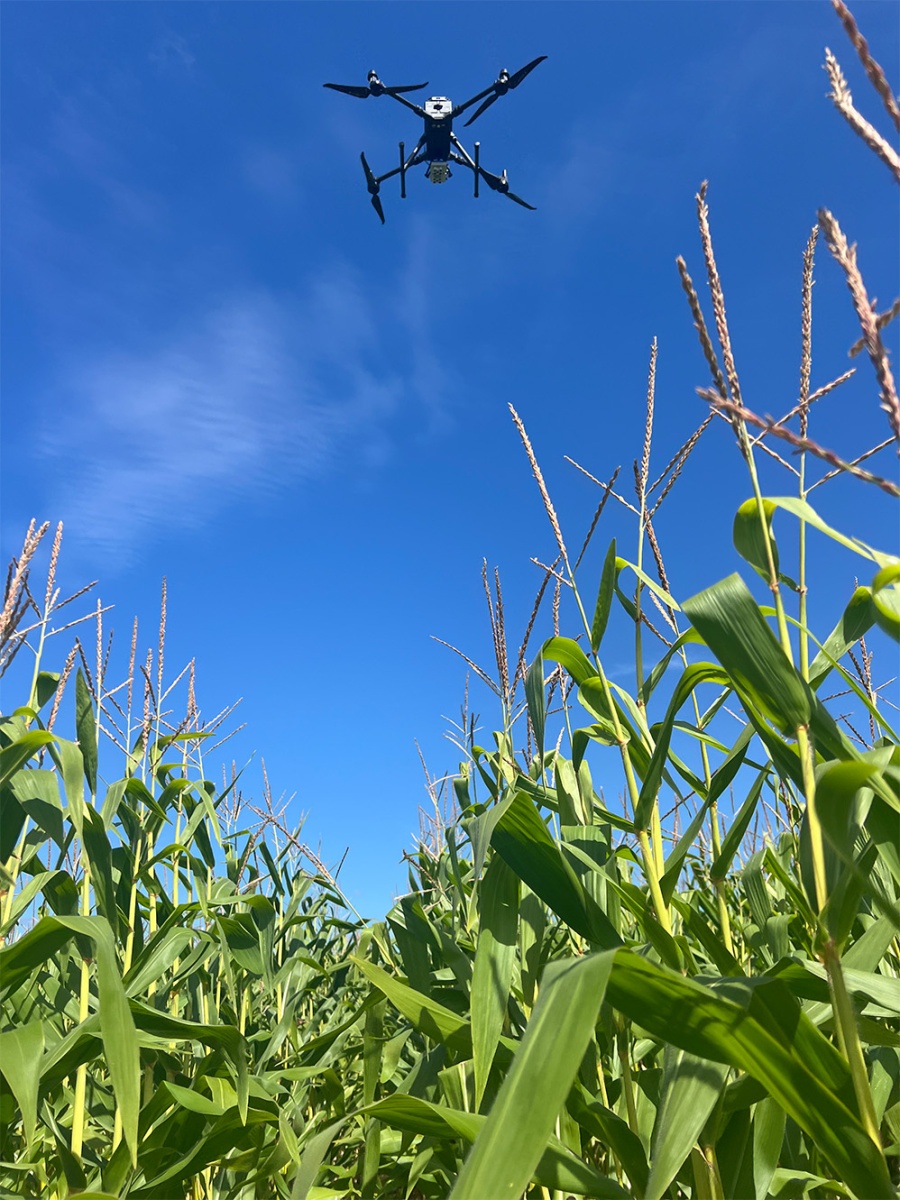From UNH News:
Seeing the last leaves hanging on to trees in late Fall is a telling sign that New England dairy farmers have wrapped up the year’s field crop operations and are starting to think about what seeds to purchase and plant next spring. For many, the Brown MidRib (BMR) corn variety is an enticing choice because it is highly digestible by dairy cows and can improve milk production. However, it is also more vulnerable to diseases that spread late in the season and is noticed too late for mitigating significant losses. Research at the University of New Hampshire is assessing whether drones could be a tool for small and medium-sized New England farms to identify plant disease pressure earlier, more accurately and at a lower cost.
The research represents a collaboration among New Hampshire Agricultural Experiment Station scientists, operations staff at UNH Farm Services, UNH Cooperative Extension field specialists and a commercial crop advisor, who initially proposed the idea based on his observations about challenges faced by northern New England dairy farmers and the research expertise at the UNH College of Life Sciences and Agriculture.

Harnessing Drone Technology for Crop Monitoring
Using drones, or Unpiloted Aerial Vehicles (UAVs), equipped with multispectral cameras, the team monitored for early signs of disease in test plots that contain both BMR and non-BMR corn varieties. The study tested the possibility of detecting fungal diseases—such as the Northern corn leaf blight (NCLB)—in BMR corn varieties potentially weeks before it becomes visible to the naked eye.
“When harvest time comes, often the BMR corn is brown from top to bottom—it doesn’t have the disease resistance of non-BMR corn, and that’s a big issue for farmers,” explained Tom Beaudry, a commercial crop advisor who works with dairy farmers across New Hampshire as well as in Massachusetts and Vermont.
“From my perspective, drones provide a completely new way to look at a cornfield,” Beaudry added. “I’m used to being on the ground, but seeing the fields from the air allows us to spot problems much earlier—sometimes before they’re even visible on the plant.”
Peter Davis, UNH’s manager of Farm Services, worked with Beaudry to implement this study. For Davis, part of the inspiration for this project came from seeing online videos of how other farming operations were integrating drone footage into their operations.
“We do all kinds of unique work here at UNH and I really want to shed more light on how we are trying to advance our farm operations,” said Davis. “So when Tom brought up the article in THRIVE about utilizing drones to scan and gather data on forest landscapes, we talked about how we might do something similar with our agricultural fields.”
Ben Fraser, a postdoctoral researcher in natural resources and the environment at UNH who, along with Station scientist Russ Congalton, a professor in the natural resources and the environment, led the research design and aerial surveillance aspects of the research, emphasized that making this technology affordable is key.
“We’re trying to figure out if we can use fewer multispectral bands on the camera—making the technology options more affordable—while still detecting differences in crop health. If we can do that, farmers could buy in for less than $5,000 and conduct these flights themselves,” Fraser said.
During this first study season, the data showed that the multispectral camera could indeed accurately differentiate corn varieties by over 98 percent.
Making Technology Accessible to Small Farms
Many existing UAV systems for agriculture are prohibitively expensive for small farms, often costing tens of thousands of dollars. A primary goal of this multi-year study is to determine how to lower these costs while ensuring the technology remains effective. According to Beaudry, drones are currently used on larger Midwest farms for disease and weed scouting purposes, both by individual farms and crop advising companies, in part because the costs can be spread over more acres.
The research team believes that if they can show the effectiveness of using lower-cost drones that can provide technically accessible data could significantly help small and medium-sized New England farmers more sustainably manage their crops. Early disease detection can help farmers apply treatments sooner, optimize application quantities, adjust harvest schedules and make better crop management decisions, ultimately reducing yield losses and improving economic returns and food-production resiliency.
“Scouting crops has always been important but having a perspective from a few hundred feet up allows you to see patterns in the field that you might otherwise miss,” said Carl Majewski, a dairy, livestock and forage crops field specialist with UNH Extension and member of the research group. “Drones could help farmers identify issues with crop health, soil health, or weed infestations, and it would be easier to see changes over time.”
Jeremy Delisle, a fruit and vegetable production field specialist with UNH Extension, said that we’re just starting to see drone usage on New Hampshire farms, but they offer incredible potential, for everything from farm planning and identifying best placements for crop and infrastructure to crop monitoring and management.
In year two of this study, the team will focus on refining their methods and look to expand the study to other farms.

 Return to the Concord Monitor
Return to the Concord Monitor